HIt seems like everyone is sick recently. COVID-19 is still circulating like crazy, but children are also getting hit with Respiratory Syncytial Virus (RSV), strep throat, stomach bugs, HFMD, the flu and other seasonal viruses. As disruptive as illness can be for work, school, and your family’s plans, it can also impact how you and your child eat. How can we feed our children who are sick so they’ll get better faster?
LOWER YOUR EXPECTATIONS

In most cases, when children are sick, it is very normal to see them have very little appetite, no interest in eating, and may even refuse food they usually eat. Even as adults, when we’re not feeling well, we tend to prefer bland, plain foods that are easy to eat as well our favourite comfort meals. We don’t usually fancy a huge variety of exciting foods when we’re not feeling well.
However, it doesn’t mean that you have to ONLY offer bland or favourite snacks to your children. The best thing to do during sick days is to keep your normal feeding routine as much as possible and rely on your child’s internal body signals. Because it’s important to help them keep their energy up and prevent pickiness after illness, and we know it’s usually only for a short period of time and it’s not going to undo any of the work that you’ve done in encouraging them to enjoy a variety of foods.
Responding to their appetite
You can continue to serve other foods alongside to keep up the variety that they are actually familiar with, but don’t be surprised if they’re not touched, or even expect them to try new foods, or foods that they’re less keen on at this time. Their appetites are likely to be all over the place, it can be hard to predict. Therefore, offering foods at set schedule whether they ask for it or not, and trust their body instincts to do the rest in terms of whether food is accepted or how much is accepted.
If they ask for food outside of mealtimes or seem hungry, that’s perfectly fine to give it to them, especially if you’re finding that there have been a few days where not much at all has been eaten. So let them follow their appetite and give them the chance to eat if they show interest. REMEMBER, it’s ok for the routine to slip as it is only for a short period of time. However, once they start to feel a little better, it’s helpful to start to build in some more structure to get things back on track.
FEED YOUR CHILDREN WHEN THEY’RE SICK WITH
i) a cold and respiratory illness
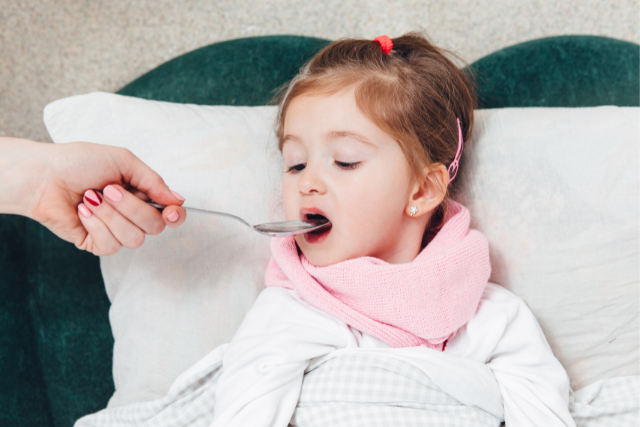
When your child has a cold or respiratory illness, it may affect their appetite and drive to eat. Between coughing, fatigue, a runny nose and sore throat, they might not want to eat or drink like they usually do. They might be tired or uncomfortable, or maybe they’re unable to smell or taste food appropriately.
The biggest concern during illness is keep the body well-hydrated to prevent dehydration. While a child might not eat as much as usual, as long as they’re drinking adequately they should be okay in the short-term.
Babies:
For babies under 12 months, getting enough milk to stay hydrated is most important during illness. Babies will likely prefer sticking to breastmilk or formula, and that’s OK. If your baby has really bad congestion, the use of a bulb suction or Nasal Spray to clear up the congestion might make eating and drinking easier. Focus on regular breastfeeds or bottle feeds and watch for 5-6+ wet diapers per day. If your baby is eating solids (6+ months), offer solid meals like usual but don’t be surprised if your baby isn’t interested. Stay consistent and continue to include your baby in family meals, as long as they’re not upset when they sit in their high chair.
Toddlers ++:
Continue to offer the regular food/meals you normally would at regular times but trust their hunger and fullness cues. Focus on lots of veggies, fruits, protein foods, whole grains and fats. Do not force or pressure them to eat. Nutrition is important during illness, but their appetite and food preferences almost definitely change. You may find your child gravitating toward certain foods or surviving on familiar beige foods like bread and crackers – this is OK. You might want to just feed them whatever sounds good for a while until they feel better. As best you can, try to offer some variety in the food groups you serve, too. They might surprise you when they are suddenly interested in something again.
Sometimes it helps to integrate warm foods into their diet, like clear soup, porridge, mee sua soup or oatmeal. The steam from these foods can help loosen mucus and provide relief from nasal congestion.
The pain of a sore throat can make swallowing food and liquids uncomfortable, which may make your toddler eat less even if they feel hungry. Acidic foods can irritate an already inflamed sore throat.
Avoid acidic foods until your toddler’s sore throat has healed:
- orange and orange juice
- pineapple juice
- tomato soup
Offering extra-cold and smooth foods may help soothe a sore throat:
- smoothies blended with frozen fruits
- frozen yogurt barks,
- popsicles
- frozen fruits
Since many cough suppressant medications are not approved for use in young children, it’s hard to know what to do with the coughing child, especially for those night time coughing. Some evidences (here, here, here, here, here) suggest that a spoonful of 100% pure honey can work as a good cough remedy for children over the age of one.
(ii) hand, foot and mouth disease
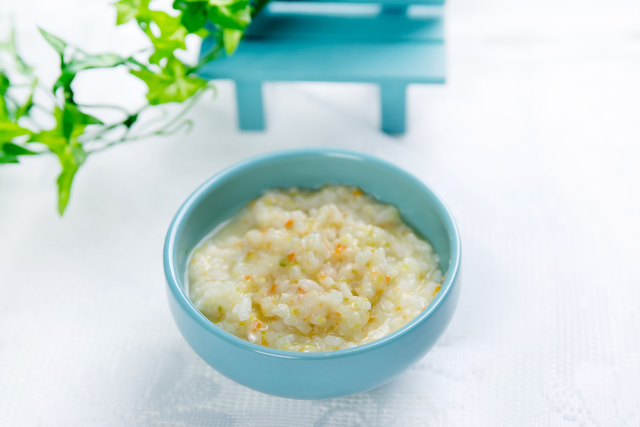
Hand, foot and mouth disease can be particularly difficult for children and mealtimes. Their mouths can get SO sore, which obviously makes it uncomfortable for them to eat. It’s especially tough as they may actually WANT to eat, they just can’t because it makes the pain so much worse.
Foods for children with hand, foot and mouth disease:
- SOFT foods such as yogurt, porridge, cereal or oatmeal are likely to go down well as they are easy to eat and shouldn’t cause too much pain to sore mouths
- Scrambled eggs, muffins or pancakes
- Soft toast fingers with toppings like avocado, cream cheese, butter or nut butter
- AVOID acidic foods such as tomato, citrus fruits or fruit juice
(iii) stomach flu (diarrhea/vomiting)

Stomach bugs or acute gastroenteritis will almost certainly affect the amount and types of food your children eats.
Babies:
Just like with respiratory illnesses, hydration is most important when babies are sick with GI bugs. Dehydration is especially dangerous with stomach bugs because babies can quickly lose fluids from vomiting and diarrhea. Continue to offer regular breastfeeds and bottle feeds and watch for 5-6+ wet diapers per day. If your baby is continually vomiting or has profuse diarrhea and you’re worried about their hydration status, speak with your doctor right away. Make sure your baby can tolerate breast milk or formula before offering bland foods like banana or crackers, then offer a regular diet if bland foods are tolerated.
Toddlers++:
Some simple guidelines to remember when our children are vomiting or have diarrhea:
- Start with small amounts of liquids to prevent dehydration.
- If those are tolerated, move onto a bland foods like toast, soup/broth, porridge, crackers, oatmeal, eggs (steam) or certain fruits (applesauce, banana, avocado, berries).
- Once bland foods are tolerated, move onto a regular, varied diet including complex carbohydrates, lean meats, dairy, fruits and vegetables. Just avoid super heavy and greasy foods like fried or fried chicken, pizzas. The BRAT (banana, rice, applesauce, toast) diet is no longer recommended by the American Academy of Pediatrics. The reason is this diet is low in calories, protein, fat, fiber and other nutrients, also it makes diarrhea last longer. Current research show that children who eat a balanced diet recover quicker from stomach flu.
- Juice is generally not recommended during stomach flu because it contains a lot of fructose and sorbitol, which can actually worsen diarrhea. If juice is all your children will drink, make sure to dilute it.
Sometimes water isn’t sufficient to rehydrate children when they’re losing fluid quickly from profuse vomiting or diarrhea. Oral Rehydration Therapy (ORT), means to drink solutions that are made with an appropriate amount of salt, sugar and fluid to help your child’s body absorb lost electrolytes appropriately. Sugar is essential in Oral Rehydration Solutions (ORS) because it helps to get the electrolytes through the bloodstream quicker and to rehydrate your children faster.
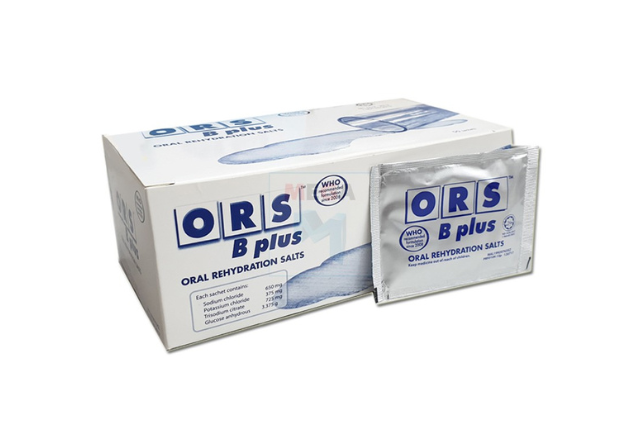
Some families make their own inexpensive ORT at home using the World Health Organization recipe. It is just as effective as expensive rehydration drinks and doesn’t contain any harmful ingredients and no dyes.
- 1/2 tsp salt
- 6 tsp sugar
- 1L water
HYDRATION IS REALLY IMPORTANT WHEN CHILDREN ARE SICK!!!
During periods of illness, the number one concern is DEHYDRATION.

Babies:
Under 12 months, babies should still be consuming at least 20-24 ounces of breast milk or formula.
Toddlers ++:
Toddlers and older children need to drink lots of water to stay hydrated and get better. Estimated fluid needs per the American Academy of Pediatrics are as follows:
- 1-3 years: 4 cups (32 ounces or ~1 L)
- 4-8 years: 5 cups (40 ounces or ~1.2 L)
- 9-13 years: 7-8 cups (56-64 ounces or ~1.7-1.9 L)
Fever, diarrhea, vomiting, or just refusing liquids for a prolonged period of time can put your toddler at serious risk for dehydration.
How to prevent dehydration
The best way to prevent dehydration and replace fluids lost through vomit, diarrhea, or sweat is to keep a cup full and encourage your child to sip from it all day long. Using a favorite cup, or straw cup to spark a toddler’s interest in drinking more.
Water is the best choice, of course, but if you’re finding it a struggle to get your child to drink it, here are some other drink ideas:
- Water or infused water
- Honey lemon water (except children under the age of 1 can’t have honey due to the risk of botulism)
- Breastmilk
- Fresh cow’s milk/plain kefir
- Plant-based milk (ex: soy, almond, oat)
- Popsicles or freezies
- Smoothies (If your child can tolerate some heavier textures, then a smoothie is a great way to boost nutrition along with fluids)
- Bone broth (homemade bone broth has the benefit of protein and additional vitamins and minerals)
- Coconut water (diluted 1:1 ratio with water) (offered occasionally, it can be a good substitute if your child likes the flavor, but it’s much lower in potassium than ORT and may not rehydrate as effectively).
- Fruit juice (diluted 1:1 ratio with water) (offered occasionally, DON’T offer if experiencing diarrhea. The risk of dehydration FAR outweighs the risk of added sugars in a juice box)
- Non-caffeinated tea in small amounts (¼ cup offered occasionally) like Chrysanthemum tea, barley tea, Luohanguo tea 罗汉果
In addition to offering more beverages, if they can still eat, make sure to offer lots of Hydrating Foods (foods with high water content) throughout the day.
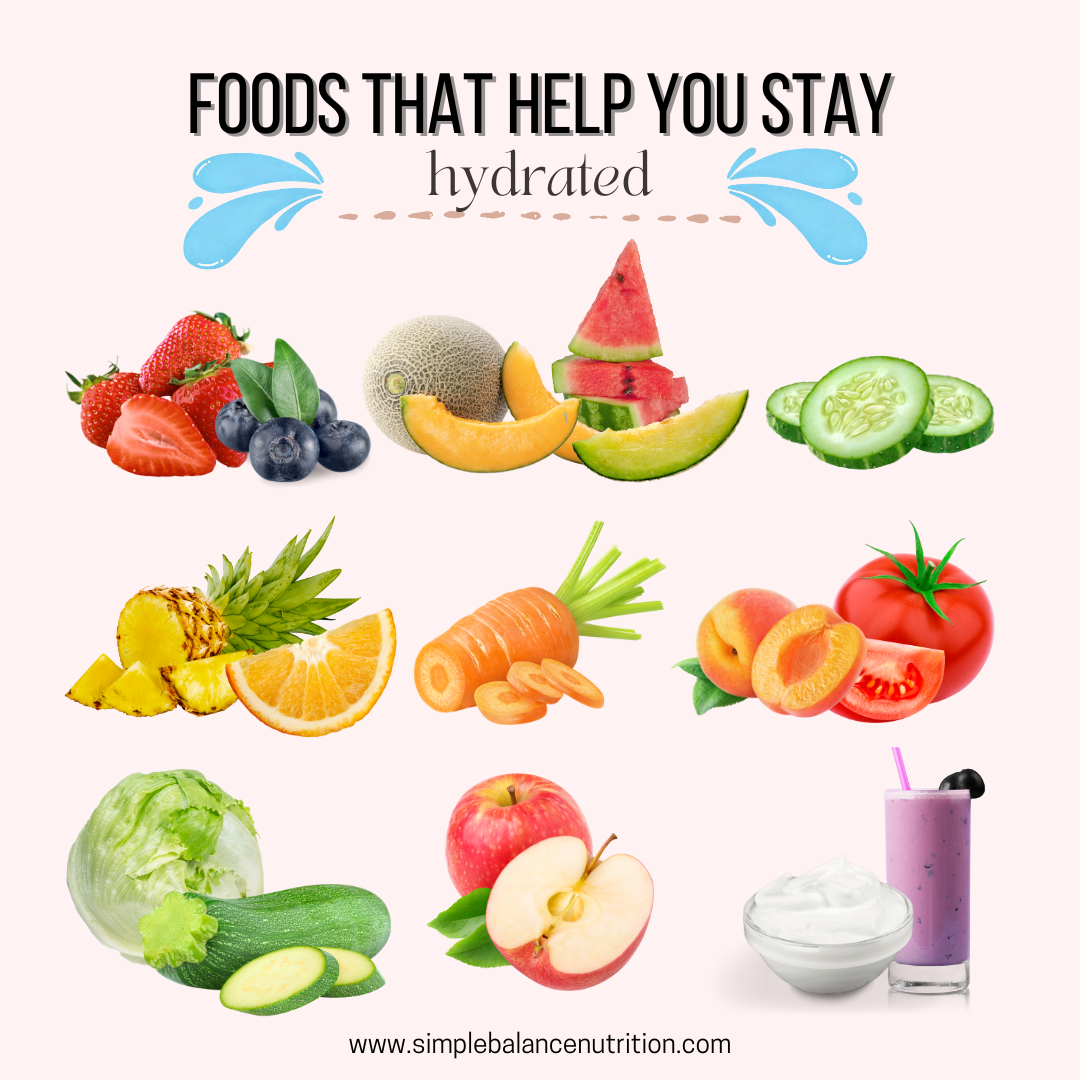
Instead of worrying about how much they are actually drinking, watch your child. Make sure they’re urinating regularly and don’t show signs of dehydration.
WHAT ARE THE SIGNS OF DEHYDRATION
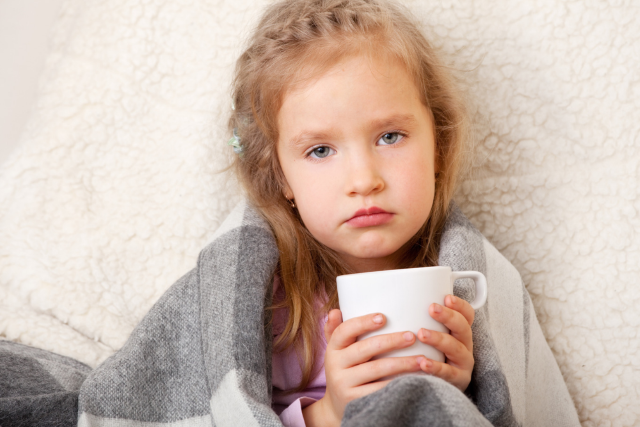
Dehydration can be dangerous for a child and severe cases may require hospitalization. If you suspect your child might be showing signs of dehydration, it’s best to call your doctor right away so they can guide you on what’s best to do. According to the American Academy of Pediatrics, the following are signs of dehydration:
Mild to moderate dehydration:
- Less activity than usual
- Less than six wet diapers a day
- Less saliva or cracked lips
- Fewer tears when crying
- Sunken soft spot on the head
Severe dehydration (all the symptoms listed above, plus):
- Very fussy or overly sleepy
- Sunken eyes
- Cool, discolored hands and feet
- Wrinkled skin
- Only 1 or 2 wet diapers in 24 hours
- Dry tongue and mouth
- No tears when crying
GAIN BACK APPETITE AFTER ILLNESS
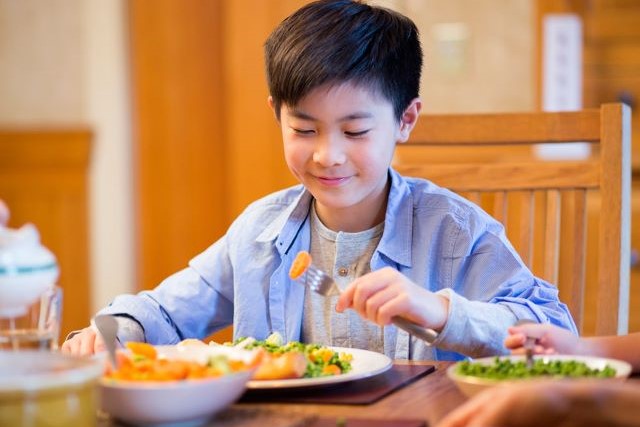
Appetite after Illness
Ever notice that it takes a few days to even weeks for your children’s appetite to return after they have been sick? Try not to panic that they’ll never eat a variety again. During illness, this is not a good time to force them to eat anything or to buy them French fries, just to get them to eat.
Another thing to remember is after an illness, your child’s taste buds may be dampened. Viruses can inhibit taste and smell function, and sometimes congestion prevents them from smelling (and thus tasting) appropriately. You may experience this as an adult, too. Adding highly flavorful food to their regular meals can help “wake up” their tastebuds and get them back to eating like normal again!
One strategy I love to use is to offer a highly flavorful, crunchy, sour or salty food once or twice a day to help “wake up” their taste buds. I found that children who have been sick sometimes seek out these flavors so they can taste again. Try foods like:
- Freeze-dried fruit (mango, strawberries, raspberries)
- Cucumber or tomato paired with a strongly flavored dip like hummus or guacamole
- Olives (remember to remove pits and quarter lengthwise for kiddos under 4 years old)
- Ground meat seasoned with cumin and garlic
- Cooking with flavorful spices like cinnamon, ginger and paprika
You can also try lemon, lime or spicy food (if your children usually enjoys and tolerates it).
Don’t be surprised if your child’s appetite takes a while to return to normal when they have been sick. If they seem to be losing weight or not improving over time, consult a dietitian.
DOES VITAMIN C HELP WITH ILLNESS?
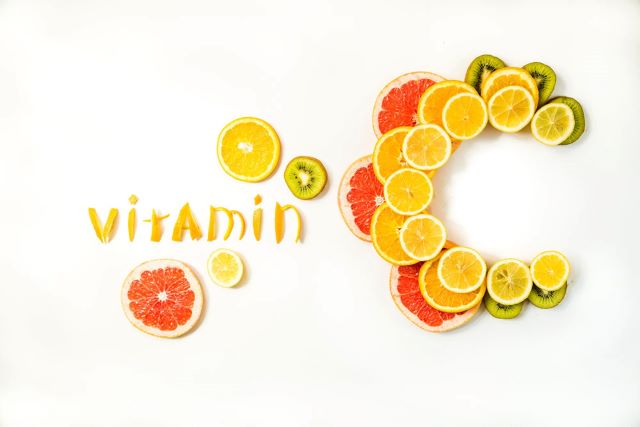
There may be NO STRONG evidence to suggest vitamin C will cure a cold. While some studies have suggested that vitamin C may shorten the duration of illness, other research does not support this theory. Plus, giving your children high vitamin C doses can cause diarrhea and stomach upset.
According to the NIH, here are vitamin C needs based on age (daily):
- 7-12 months: 50 mg (Adequate Intake)
- 1-3 year-olds: 15 mg
- 4-8 year-olds: 25 mg
- 9-13 year-olds: 45 mg
In general, unless your child has an extremely limited diet or malabsorption issues, they likely don’t need a vitamin C supplement.
FOODS HIGH IN VITAMIN C
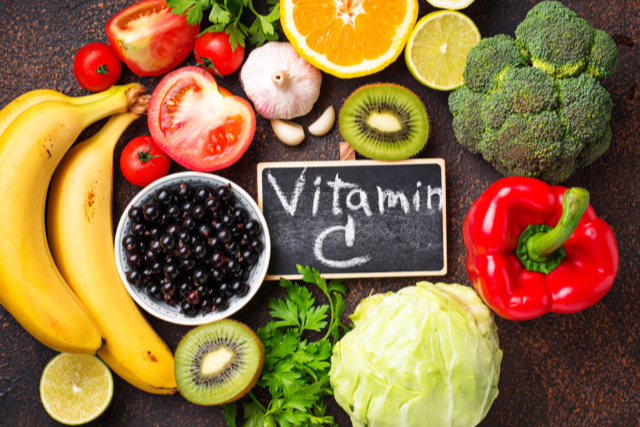
Since vitamin C can’t cure a cold, but it can support the immune system. Oranges are not the only way to get your daily dose of vitamin C! Many fruits and veggies – yes, even bell pepper – can fulfill a great percentage of your child’s daily needs. Below are some kid-favorite foods that are high in vitamin C:
- Potato (medium, cooked) – 15 mg
- Tomato (medium, raw) – 16 mg
- Mango (1 cup) – 45 mg
- Broccoli (1/2 cup) – 61 mg
- Orange (medium) – 70 mg
- Kiwi (medium)– 75 mg
- Strawberry (1cup) – 95 mg
- Red bell pepper (1 whole, raw) – 312 mg
Breast milk and formula are great sources of vitamin C, too! In fact, babies’ vitamin C needs are met by their milk alone.
Interestingly, vitamin C also helps our bodies absorb iron, so pairing a high vitamin C food with high iron foods like meats, poultry, fish, lentils, beans and nut butters can help your child’s body absorb iron, a critical nutrient in childhood.
SHOULD MY SICK CHILD AVOID MILK AND DAIRY?
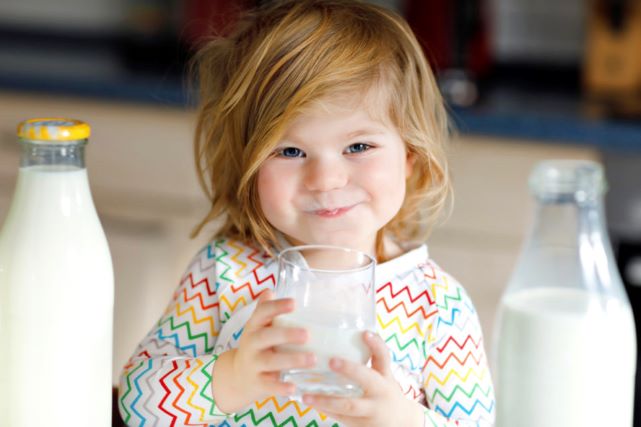
There have been many studies that have looked at the relationship between drinking milk and how it affects mucus production but there is NO scientific evidence to suggest that there is any relationship. However, if you notice your child’s symptoms seem to worsen after a cup of milk or yogurt, you can go ahead and remove it from their diet until they are healthy again.
If your toddler is having a stomach flu, serving dairy can be iffy. It is because sensitive stomach may have a hard time digesting dairy. Again, if you notice any changes or are worried dairy could potentially worsen their symptoms, it’s best to skip it for couple days.
HOW TO GET YOUR CHILDREN TO TAKE MEDICINE?
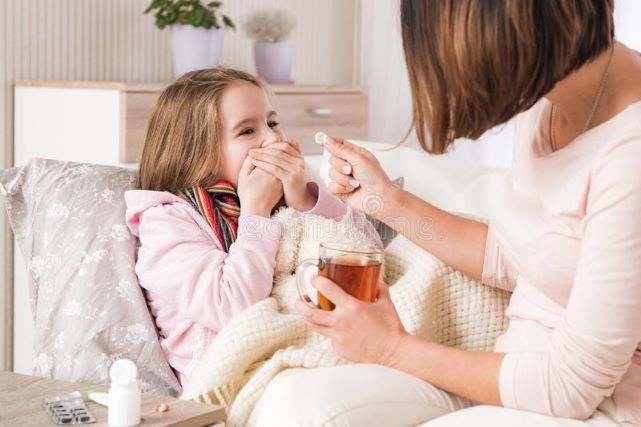
There’s nothing worse than a sick child who would feel much better if they just took their medicine. If your children refuses prescribed meds, here is an amazing blog post from physician Steve Silvestro, MD on various ways to make taking meds a little easier on everyone.
BOTTOM LINE
Caring for sick children is hard! Be sure to reach out for help and call on your support network for meals or runs to the pharmacy when needed! I hope this article helped to answer your question. For more support feeding children, be sure to check out my 3 months TRANSFORM program.

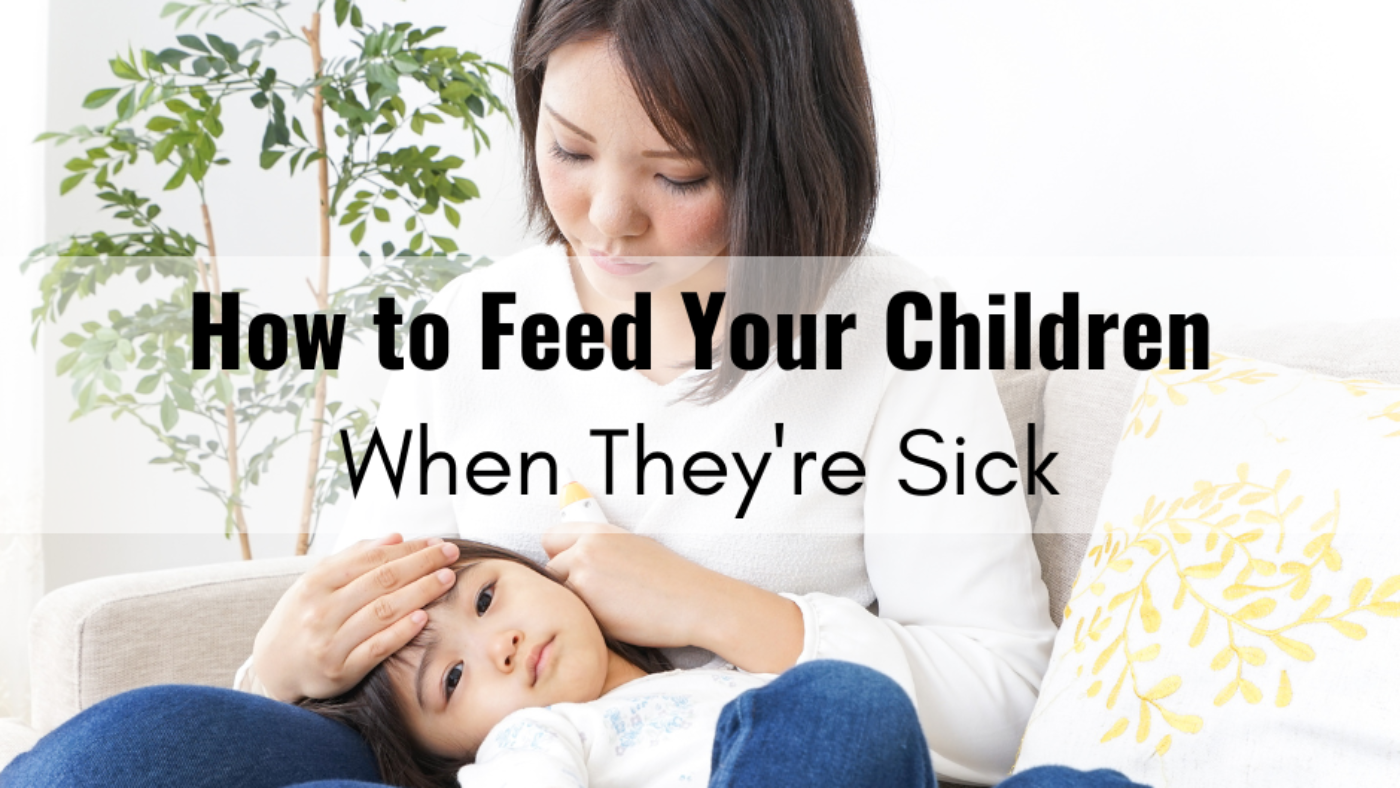
Leave A Comment